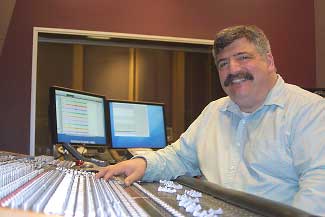David Greenspan, coordinator of audio resources at the Digital Media Commons in the Duderstadt Center on North Campus, played a fundamental role in renovating the University’s audio resource center into a world-class recording studio, to give students unique opportunities to experiment with sounds.

“How many students can say they have mixed compositions or experimented with sound on a 40-channel, analog API Vision surround sound mixing and recording console?” Greenspan asks. “With only seven of these custom-built consoles in the world, I would guess the number of students would be few and far between.”
The facility at the Duderstadt Center on North Campus serves as a recording studio, a research lab and a classroom.
Greenspan acted as an on-site consultant throughout the entire transformation, from choosing the best technological equipment for the room to spending hours with the architects interpreting construction plans.
Speakers encircle the control room where the oversized analog console rests. Two large computer screens allow students to view and experiment with sound recordings.
“The audio center’s recent renovations were achieved quite quickly,” Greenspan says. “The plan was molded in December of 2005, construction began early in 2006 and the room reopened in September. It is currently 97 percent finished after a little more than a year of overall design work. This kind of plan generally takes two years to complete, so we’re ecstatic with these results.”
Prior to employment at the University, Greenspan worked at the Interlochen Center for the Arts in Traverse City for 18 years as a recording programmer. In the midst of looking for new opportunities, a former student called to inform him of the U-M position. Shortly after moving to Ann Arbor, Greenspan learned of the Digital Media Commons’ desire to upgrade the sound studio.
“I knew the renovated studio would be an excellent way to foster the creative learning process with students. The provost’s office has given the Digital Media Commons and its members the capability to experiment with so many exciting prospects.”
The studio’s advanced capabilities allow students to experiment with sound by testing new variables and examining results. “Today, with the new renovations, students can start with one element of sound at a time and then continue to explore their options,” Greenspan says. “For example, a student may record a single artist’s voice at one point in time. Later on, they have the capability to add other elements of sound like more vocals, guitars, drums; the possibilities are endless!”
Students who pursue sound engineering as a field of study have gone on to work with Bose, Analog Devices, Shure microphones and other top sound-related companies. Dan Charette, a student majoring in performing arts technology, recently worked with Greenspan to mix a rock music recording in surround sound.
“Anyone coming into the studio is only limited by his or her own creativity,” Greenspan says. While the studio encourages research, teaching and learning, Greenspan is quick to point out the equal footing he stands on with students involved at the audio studio. “We’re like a family here,” he says. “We all want to have some input and be involved in making things work.”
Outside of work, Greenspan enjoys snow skiing and attending family reunions in South Carolina. He and wife, Gerie, have one daughter, Olivia.

